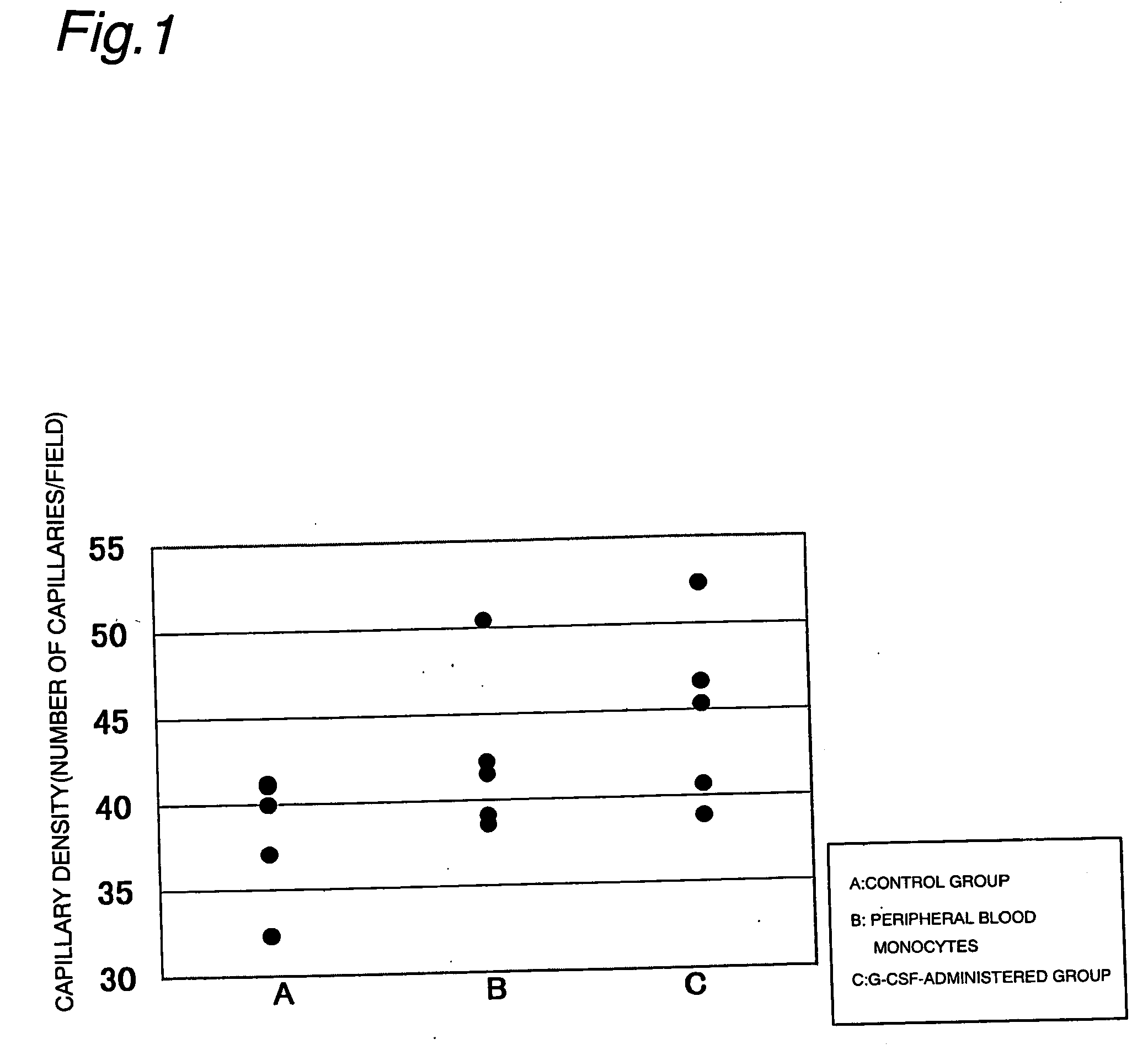Remedies for ischemic diseases
a technology for ischemic diseases and agents, applied in the field of agents for treating ischemic diseases, can solve the problems of no radical therapeutic agents available for obstructive arteriosclerosis, no effective exercise therapy, difficult to predict the effect of this therapy, etc., to accelerate hematopoietic recovery, accelerate hematopoietic recovery, and facilitate neutrophilic hematopoiesis
- Summary
- Abstract
- Description
- Claims
- Application Information
AI Technical Summary
Benefits of technology
Problems solved by technology
Method used
Image
Examples
experimental example 1
Pharmacological Efficacy
[0022] The left femoral artery and vein of nude mice (BALB / cAJcl-nu) were ligated and then removed to prepare lower limb ischemia models. In an untreated group, the lower limb dropped out in 3 of 5 animals (60%) and became necrotic in 2 animals (40%) two weeks after ischemic treatment. In a group subcutaneously administered 100 μg / kg / day of G-CSF a total of 5 times from 3 days before creation of lower limb ischemia until 1 postoperative day, the fall and the necrosis of the lower limb were observed in 1 (20%) and 3 (60%) animals out of 5, respectives, and no damage was observed in 1 animal (20%), at 2 weeks post ischemic treatment. Thus the lower limb damage was reduced in the G-CSF treated group. These findings show that G-CSF may have the action of alleviating lower limb damage after ischemia by promoting angiogenesis.
experimental example 2
Pharmacological Efficacy
[0023] After 100 μg / kg / day of G-CSF was subcutaneously administered to mice (BALB / cA) for 5 days, blood was taken, and a mononuclear cell fraction was obtained by the density gradient method (d=1.077). Also, the left femoral artery and vein of nude rats (F344 / N Jcl-rnu) were removed to prepare lower limb ischemia models. One day after creation of ischemia, peripheral blood mononuclear cells from the G-CSF-treated mice were intramuscularly inoculated in a dose of 2×107 cells / head (corresponding to about 5 ml of peripheral blood) to the ischemic limb of the lower limb ischemia nude rat. A control group received in intramuscular administration of phosphate buffer. One week after inoculation, a tissue specimen of the lower limb was prepared, and the density of capillaries was measured after an alkaline phosphatase stain. As a result, the capillary density tended to be higher in the peripheral mononuclear cell treatment group than in the control group (control gr...
experimental example 3
Pharmacological Efficacy
[0025] The left femoral artery and vein of nude rats (F344 / N Jcl-rnu) were removed to prepare lower limb ischemia models. The density of capillaries was measured by alkaline phosphatase stain of a lower limb tissue specimen prepared one week after creation of ischemia. Comparisons were made between a group subcutaneously administered 100 μg / kg / day of G-CSF from 4 days before creation of ischemia until one week after creation of ischemia (G-CSF treatment group) and a control group. The control group received an intramuscular administration of phosphate buffer. As a result, the capillary density was shown to be higher in the G-CSF treatment group than in the control group (control group: 38.3±1.7, G-CSF treatment group: 44.7±2.4, number of capillaries / field, 5 animals per group, mean±standard error). The results are shown in A and C of FIG. 1.
[0026] These results suggest that G-CSF has the effect of promoting angiogenesis at the site of ischemia, and suggest ...
PUM
 Login to view more
Login to view more Abstract
Description
Claims
Application Information
 Login to view more
Login to view more - R&D Engineer
- R&D Manager
- IP Professional
- Industry Leading Data Capabilities
- Powerful AI technology
- Patent DNA Extraction
Browse by: Latest US Patents, China's latest patents, Technical Efficacy Thesaurus, Application Domain, Technology Topic.
© 2024 PatSnap. All rights reserved.Legal|Privacy policy|Modern Slavery Act Transparency Statement|Sitemap

